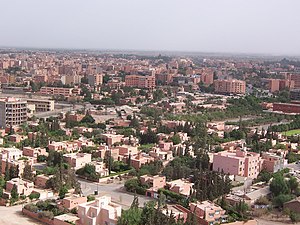 Marrakech or Marrakesh (مراكش Marrakesh), known as the "Red City" or "Al Hamra," is a city with a population of 1,036,500 (as of 2006) in southwestern Morocco, near the foothills of the Atlas Mountains.
Marrakech or Marrakesh (مراكش Marrakesh), known as the "Red City" or "Al Hamra," is a city with a population of 1,036,500 (as of 2006) in southwestern Morocco, near the foothills of the Atlas Mountains.Name
The possible origin of its name could be from the Tamazight (Berber) words mur (n) akuch, which means "Land of God". (The root "mur" is now in the Berber languages used only in the feminine form "tamurt"). The same word "mur/mawr" appears in the country Mauritania, but this interpretation is still unproven to this day. There are other possibilities that are often invoked.
This city is the capital of the Marrakech-Tensift-El Haouz region.
Marrakech has the largest traditional market (souk) in Morocco and also has one of the busiest squares in Africa, Djemaa el Fna. The square bustles with acrobats, story-tellers, water sellers, dancers, and musicians, as well as drug lords by day; By night, the square turns into food stalls,  becoming a huge open-air restaurant with busy life that include the infamous Ladies of the Night(prostitutes).
becoming a huge open-air restaurant with busy life that include the infamous Ladies of the Night(prostitutes).
 becoming a huge open-air restaurant with busy life that include the infamous Ladies of the Night(prostitutes).
becoming a huge open-air restaurant with busy life that include the infamous Ladies of the Night(prostitutes).Like many North African and Middle Eastern cities, Marrakech comprises both an old fortified city (the médina) and an adjacent modern city (called Gueliz). It is served by Ménara International Airport (RAK is the code for the airport) and a rail link to Casablanca and the north.
The city is spelled "Marrakech" in French, "Marrakesh" in English, and "Marrakesch" in German.
History
Marrakesh is the third largest city in Morocco after Casablanca and Rabat. It was known to early travellers as "Morocco City." Prior to the advent of the Almoravids in the 11th century, the area was ruled from the city of Aghmat. The Almoravid leader, Abu-Bakr Ibn-Umar decided Aghmat was becoming overcrowded and chose to build a new capital. Being a nomad from the Sahara Desert, he decided to build it in the plains, away from the mountains and rivers. He chose the site of Marrakech, because it was in neutral territory between two tribes who were vying for the honor of hosting the new capital. Work started in May 1070, but Abu-Bakr was recalled to the Sahara to put down a rebellion in January 1071 and the city was completed by his deputy and eventual successor Yusuf ibn Tashfin. The city experienced its greatest period under the leadership of Yacoub el Mansour, the third Almohad sultan. A number of poets and scholars entered the city during his reign and he began the construction of the Koutoubia Mosque and a new kasbah.
Prior to the reign of Moulay Ismail, Marrakech was the capital of Morocco. After his reign, his grandson moved the capital back to Marrakech from Meknès.
For centuries Marrakesh has been known for its 'seven saints.' When sufism was at the height of its popularity, during the reign of Moulay Ismail, the festival of the 'seven saints' was founded by Abu Ali al-Hassan al-Yusi at the request of the sultan. The tombs of several renowned figures were moved to Marrakesh to attract pilgrims in the same way Essaouira did at that time with its Regrega festivals. The 'seven saints' (sebaatou rizjel) is now a firmly established institution, attracting visitors from everywhere. The seven saints include Sidi Bel Abbas (the patron saint of the city), Sidi Muhammad al-Jazuli, Sidi Abu al-Qasim Al-Suhayli, Cadi Ayyad ben Moussa, and Abdallah al-Ghazwani.
Marrakech was dominated in the first half of the 20th century by T'hami El Glaoui, Lord of the Atlas and Pasha of Marrakech. The poet of the city was Mohammed Ben Brahim, his favorite place was café Al-Masraf. The poems and songs of Ben Brahim are still known by heart by many Marrakshi.